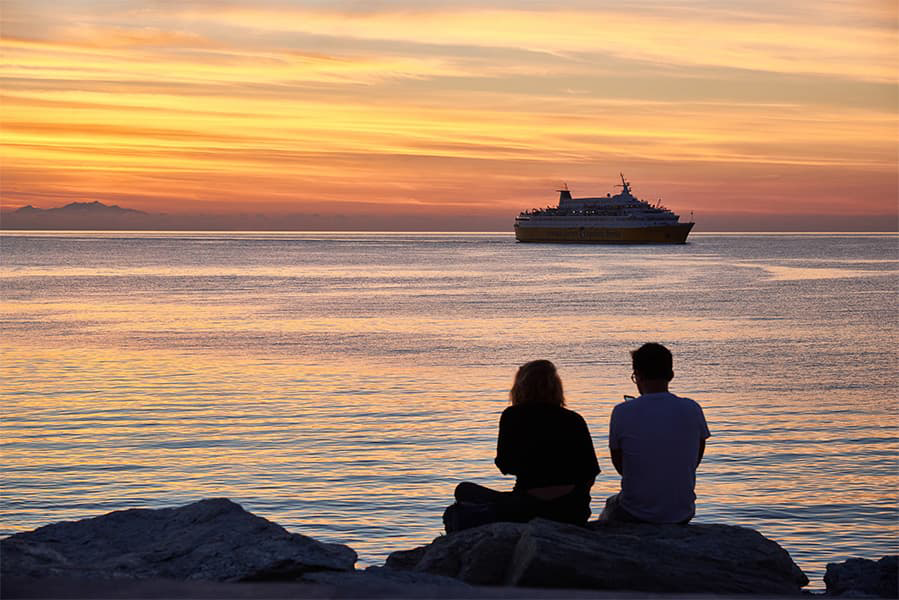Ferries from
Germany to Lithuania
Ferries from
Germany to Lithuania


There are 3 ferry routes. Ferries from Kiel to Klaipeda and Travemunde to Klaipeda are popular ferry trips from Germany to Lithuania. Sailing frequency can change throughout the year and often sailings increase during peak season.
Ferries from Germany to Lithuania sail approximately 9 times per week and are available with TT-Line.
The ferry from Germany to Lithuania takes between 7 hours 20 minutes and 39 hours 35 minutes depending on the ferry route, operator, and ship that you choose.
The fastest ferry from Germany to Lithuania is on the Travemunde to Klaipeda ferry with TT-Line in 7 hours 20 minutes.
Yes, there are car ferries available from Germany to Lithuania with TT-Line.
There are approximately 720 miles (1159km) and 626 nautical miles between Germany and Lithuania.
The price of a ferry from Germany to Lithuania can differ by route, operator, season, vehicle type and whether you are sailing on a high-speed ferry or conventional ferry.
The Kiel to Klaipeda ferry ferry sails approximately 6 times weekly with a crossing time of 20 hours 30 minutes.
Travemunde to Klaipeda ferry ferries sail about 3 times weekly with a sailing time of 31 hours 20 minutes.
We suggest that you book in advance to ensure that you get the cheapest ferry prices and availability. Please check out our special offers page to take advantage of all the latest ferry discounts available.
Book and compare Germany Lithuania ferry tickets, operators, timetables and prices by using our Deal Finder.
More routes than anyone else.

Compare fares, times & routes in one place.
Change plans easily with flexi tickets.

Book e-tickets & manage trips in-app.
Live ship tracking & real-time updates.

Top-rated customer support when you need it.
Being the largest country in Central Europe, Germany offers even a casual visitor a wealth of sights and sounds from hyper modern and fashionable cities to the sublime southern regions that border the Alps. Beautiful, vibrant cities display some of the very best of what the country has to offer, while in the quieter corners of the country, the landscape is filled with significant UNESCO World Heritage sites and unspoiled treasures. With its prime position in the Baltic Sea, Germany is the perfect gateway to mainland Europe with ferries arriving from Scandinavia, Eastern Europe, and Russia. The ports of Kiel, Rostock and Travemunde are the more popular destinations and can be reached from Sweden, Denmark, Finland, Lithuania, Latvia and Norway. The port of Sassnitz is another option for those coming from Sweden and also provides a link from the island of Bornholm while Lubeck is destination for ferries departing on the long trip from Russia. The shortest and most frequently operated route to Germany is the 12 mile ferry link between Rødby (Lolland,Denmark) and Puttgarden, a village on the island of Fehmarn. The trip takes around 45 minutes and there are up to 2 sailings an hour. Poland is also a good alternative entry point for those travelling to Germany. Though some of the of the departure ports are the same as those used for the crossings to Germany, the schedule and duration at sea may be a better fit for your plans. If you're travelling from the UK to Germany, as the direct link from Harwich to Cuxhaven ceased many years ago, you'll need to travel via France, Belgium or Holland and drive across. Whether the country is your final destination or you’re just passing through, all of Germany's major towns and cities are well connected by major infrastructure, and offer many options for onward travel. The German motorway network covers some 7,500 miles ranking it among the most dense and longest highway systems in the world. For those that aren't travelling by vehicle, the German railway network is modern, comprehensive and very efficient, not just domestically but also for onward travel to countries all over Europe.
Lithuania is the southernmost of the Baltic States in Northern Europe, with a short coastline on the Baltic Sea. Gaining independence from Russia after the First World War, Lithuania has since flourished, with an increasing number of tourists unearthing its natural splendour and marvellous cities. Lithuanian landscapes consist primarily of undulating hills, lush forests, glistening lakes and meandering rivers. The coastline, albeit small, is beautiful, and the UNESCO World Heritage-listed Curonian Spit, a thin stretch of silver sand, tops the list of Baltic beaches. The capital is Vilnius, an eastern city characterised by beautiful baroque buildings, cobbled alleyways, endless church steeples and one of the largest Old Towns in Europe. Also, standing elegantly between the Neris and Vilnia rivers, it’s an artist’s dream. Ferries from a couple of European countries sail across the Baltic Sea to the Lithuanian city of Klaipeda. Regular long-haul crossings are available, so be sure to book some comfortable accommodation.